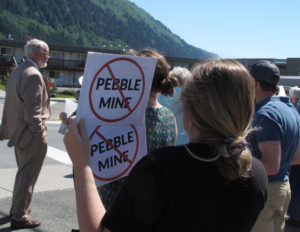A Trashing as Old as Suffrage
None of Sarah Palin's numerous shortcomings excuse the sexist cant that she, like Hillary Clinton before her, has been subjected to since she burst onto the national scene.As Donald Rumsfeld might put it, there is only one known known in the tsunami of speculation touched off by Sarah Palin’s announcement that she’s stepping down as governor of Alaska: The media will almost certainly have Palin to kick around some more.
Her forthcoming book is going to be fodder for who knows how much dissection, and her obvious earnings potential on the conservative talking-head circuit means that even should she eschew a future run for public office, she’s very likely to remain in the public eye.
And it is equally likely that the media will continue to subject Palin to the unapologetic sexism that has been directed at her since the very first hours after John McCain announced that she was his pick to be the Republican vice presidential nominee — and which continued to animate coverage of her, right up through a lengthy political profile in the current issue of Vanity Fair.
Almost as certain, my colleagues will seek to defend the indefensible as something Palin brought upon herself — by being too ignorant, too unpredictable, too touchy, too hypocritical, too loose with facts, too inept at governing, too flirty, even too obviously fertile.
Yes, this is one of the assertions made in the Vanity Fair profile. It declares that Palin is “the first indisputably fertile female to dare to dance with the big dogs,” and notes that some McCain campaign aides (unnamed, of course) speculated that Palin’s erratic performance last fall might have been due to postpartum depression being suffered after her son Trig’s birth a few months earlier.
Not to be outdone, CNN’s Rick Sanchez, anchoring the network’s coverage of Palin’s resignation announcement, asked, “Hey, could she be pregnant again?” A stammering Candy Crowley could only reply: “Well, I, I certainly don’t know the answer to that last thought.”
At this point, I will provide the requisite disclaimers: I disagree emphatically with Palin’s ideology and with her policy prescriptions on just about every issue. I, too, find her intellectual emptiness to be frightening in a public official, and her demonstrably poor judgment disqualifying.
None of this excuses the sexist cant that Palin, like Hillary Clinton before her, has been subjected to since she burst onto the national scene.
Immediately after McCain’s choice of Palin was announced — knowing just about nothing about her governing record, having no inkling that she was unprepared for national office and ill-suited to the rigors of a national campaign — mainstream media figures asked aloud if she could possibly run for vice president and be mother to five children, too.
The sexist hazing became a leitmotif many weeks before Palin disintegrated under Katie Couric’s questioning in those pivotal — and, it must be noted, entirely professional — CBS News interviews.
Almost as soon as she’d finished her breakthrough speech at the Republican National Convention, one columnist for the liberal online magazine Salon called Palin a “dominatrix” and a “pinup queen,” referred to her “babaliciousness” — and described her convention address as having been charged with enough sexual energy to give the partisan crowd a “collective woody.” Another Salon columnist described Palin as a “Christian Stepford wife in a ‘sexy librarian’ costume” who was, for the most ideological Republicans, a “hard-core pornographic centerfold spread.”
Palin early on was called “Stepford Barbie” and “Caribou Barbie” — terms used even by highbrow commentators who found it acceptable to liken Palin to the impossibly proportioned fashion doll. The Barbie epithet marked Palin as an object of sexualized fashion fascination well before it came to light that the vice presidential nominee had used Republican Party funds to buy an expensive campaign wardrobe.
When did such a savage strain of sexism become acceptable public discourse?
Why does the same combination of bemused condescension and uninhibited vitriol that the media of a century ago showed toward the suffragists persist today?
Palin most likely will fade away as a meaningful political figure to all but her admirers on the far right. It is more relevant to ask not what she will do next, but how the political media will treat the next Sarah Palin or Hillary Clinton — who, you may recall, was subjected to a Washington Post analysis of a bare hint of cleavage that showed beneath a business suit. It appeared months before the first Democratic primary vote was cast.
More than 100 years of sexist media treatment of women political leaders is, for me, quite enough. Whether it is for anyone else remains to be seen.
Marie Cocco’s e-mail address is mariecocco(at)washpost.com.
© 2009, Washington Post Writers Group
Your support matters…Independent journalism is under threat and overshadowed by heavily funded mainstream media.
You can help level the playing field. Become a member.
Your tax-deductible contribution keeps us digging beneath the headlines to give you thought-provoking, investigative reporting and analysis that unearths what's really happening- without compromise.
Give today to support our courageous, independent journalists.






You need to be a supporter to comment.
There are currently no responses to this article.
Be the first to respond.